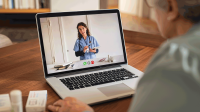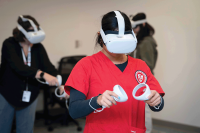ANA 2018 Quality and Innovation Conference
By Susan Trossman, RN
Registered nurses are keen observers, willing to take action when they identify a need or problem, and they have the collaborative skills that can help them turn their ideas into real-world solutions.


“You have the ability to do more innovation than anyone [within healthcare],” business futurist and inventor Nicholas Webb told the nearly 1,000 RNs and other professionals attending the American Nurses Association’s (ANA) 2018 Quality and Innovation Conference this spring in Orlando. He pointed to nurses’ history of innovation, including the achievement of Jean Ward, a nurse who first recognized the effects of sunlight on jaundice in newborns, leading to the creation of neonatal phototherapy in the 1950s.
But the thrust of his keynote presentation focused on the critical role nurses can and must play in the dynamic, fast-changing healthcare environment of the future.
“Our patients are looking for a ‘consumerized’ experience,” said Webb, who noted that companies like Amazon have helped to fuel this trend with services like Amazon Prime. “Nurses’ role in how we deliver consumer experiences is absolutely critical.”
He foresees a future where consumers will have more healthcare choices, and will want more human-focused, personalized care at every step—or “touchpoint”—of the healthcare process. That means they will no longer accept waiting 7 days for an appointment and 2 hours at the physician’s office before receiving a diagnosis that might be correct only 50% of the time. Clearly, innovative models of care are needed.
Continuing into the future, Webb stated that most nurse-led innovations likely would focus on new ways to improve workflow, quality, safety, and the patient experience. And he said innovation will be a core competency within nursing.
Webb emphasized the ongoing importance of genomics and innovation around technology in healthcare. For example, he pointed to innovative wearable technology, which can gather more and better data to help healthcare professionals anticipate disease processes in patients sooner, and, as a result, intervene sooner.
This “anticipatory healthcare” will lead to lower costs and ultimately better outcomes for patients, he noted.
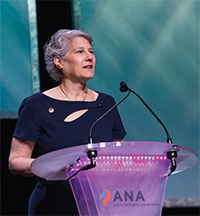

ANA President Pamela F. Cipriano, PhD, RN, NEA-BC, FAAN, also focused on the many changes taking place in healthcare, noting Apple’s entrance into the electronic health record game with Apple Health and CVS’s purchase of insurer Aetna.
“This is our landscape in 2018, and disruption is ubiquitous,” Cipriano said. “The landscape may be changing, but we [nurses] are steadfast in our goals to provide the safest, highest quality healthcare to all.”
To help nurses meet these goals, ANA’s conference provided participants with the opportunity to learn about and share successful strategies and real-world innovations around quality, safety, and staffing that they could bring back to their own facilities.
Let the innovation begin


Capitalizing on innovative formats, ANA held its first and nursing’s largest-ever hackathon, an approach that uses crowdsourcing to find solutions to intractable problems.
In this instance, conference attendees were asked to use their innovative thinking to determine ways to advance safe patient handling and mobility, prevent violence against nurses, strengthen moral resilience and ethical practice, and protect healthcare workers against needlestick and sharps injuries. Participants initially generated their own ideas on assigned topics and subsequently shared them with other nurses at their tables. In a succession of votes with increasingly larger groups, hackathon participants ultimately selected 8 winning solutions.
Among the innovations were:
- a relaxing virtual reality room—equipped with appropriate lighting, aromatherapy, and a sound system—where nurses could take a much-needed break from their unit
- an app nurses could use to report their own violent incident, potentially get help right away or be connected with a violence prevention advocate, and track the total number of violent incidents in a 24-hour period
- disposable, affordable gloves that would serve as armor against needlesticks and other sharps injuries.
Conference participants also had the opportunity to hear from panelists who shared their personal journeys in innovation, their work, and some practical and inspiring strategies.
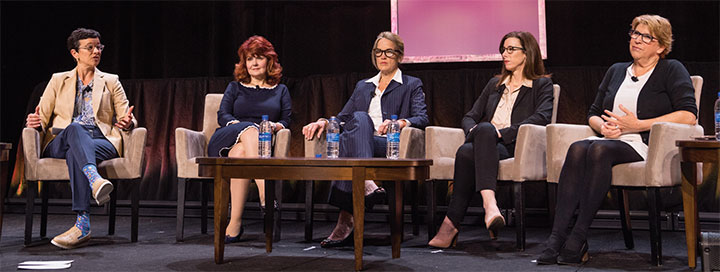

“My innovation journey started out of necessity,” said Kristi Henderson, DNP, NP-BC, FAAN, FAEN, a Texas Nurses Association member. While running a trauma center in Mississippi, she witnessed firsthand the great distances people in rural areas had to travel to access lifesaving and other vital healthcare. To provide them with the care they needed, she led the development of the first telehealth program for her healthcare system, which also used nurse practitioners.
“We saw the difference we made, so we ended up taking the program statewide,” Henderson said. Now vice president for patient access, healthcare transformation and virtual care at Ascension Healthcare, she continues to use technology to integrate services and deliver care in homes, workplaces, and other locations.
Christi DeLemos, MSN, CNRN, ACNP-BC, an ANA\California member, uncovered a knowledge gap among nurses while hospitalized after falling off a horse. She realized that some nurses lacked solid neurological assessment skills, as well as easily accessible information on neurological conditions. As a result, DeLemos, director of advanced practice, patient care services, UC Davis Health, Sacramento, developed a free, mobile app called Neuroscience Nurse that gives nurses’ point-of care access to information on stroke, traumatic brain injuries, and other neurological issues.
Michele Davey, RN, didn’t like waking pediatric patients while unwrapping Velcro protective covers to check their I.V. sites. Davey, a clinical nurse at Children’s Hospital of Philadelphia, knew there had to be a better way. So she and her colleagues began experimenting with plastic bags, fabrics, and other materials to create a better I.V. site protector, testing their early models on their own children. Their innovative thinking eventually led to co-developing, in collaboration with Medline, a see-through, wrap-around I.V. protector with a quiet closure called the See IV, which is expected to hit the market soon.
Offering some advice
The panelists also offered attendees inspiration and strategies to begin their own innovation journeys.
“We need to get people to believe in their own creativity,” said Karen Tilstra, PhD, co-founder of the Florida Hospital Innovation Lab, where nurses and others can bring their challenges and innovate solutions in a safe, trust-based space, and connect with leadership. (Conference attendees also had the opportunity to tour the lab).
“Innovation is always a step in the dark,” she said. “It takes courage. But you don’t have to know everything to start [finding solutions].” She also described the importance of building authentic connections with team members, because those connections can help when undertaking future challenges.
Davey, who now also helps guide nursing ideas and projects with the office of entrepreneurship and innovation at her hospital, added, “If you believe in a project, you can get the help you need.” She also emphasized that it’s important for nurses to consider whether their innovation will improve patient care and free up resources, as well as determine if their idea already exists.
Henderson pointed out the importance of persistence. She faced and overcame technical, policy, reimbursement, and other barriers along the way to get the telehealth program in Mississippi up and running. “What was rewarding was the community, grassroots support we received,” she said.
More learning and networking opportunities
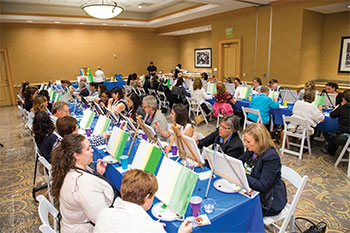

Participants had the opportunity to learn even more quality and innovation strategies through about 25 concurrent sessions and about 140 poster presentations, visit nearly 100 exhibitors, and engage in formal and informal networking activities. Concurrent session topics covered the gamut, from enhancing quality through changes in staffing, to the effect of workrelated stress on positive thinking in acute care nurses, to reducing alarm fatigue for improved patient safety and quality. Attendees were able to earn a maximum of 20.25 contact hours from the conference.
Cipriano also spoke to ANA’s theme for 2018, the Year of Advocacy. She raised nurses’ past and ongoing advocacy on the legislative front, as well as self-advocacy. Regarding the latter, she addressed ANA’s innovative Healthy Nurse, Healthy Nation™ Grand Challenge to improve RNs’ health and well-being, and another ANA initiative, #EndNurseAbuse, which in part, calls for zero-tolerance policies when it comes to violence against nurses.
Cipriano also announced the launching of a new program, the ANA Innovation Awards™. They are made possible through the generosity of BD, a global medical technology company, and will be presented to a nurse and to a nurse-led team who best exemplify nurse-led innovation. (Stay tuned for more details on this new initiative.)
The 2019 ANA Quality and Innovation Conference will be held April 24-26 at Gaylord Palms Resort and Convention Center in Orlando.
Susan Trossman is a writer-editor at ANA.
May 2018 Frontline FINAL













